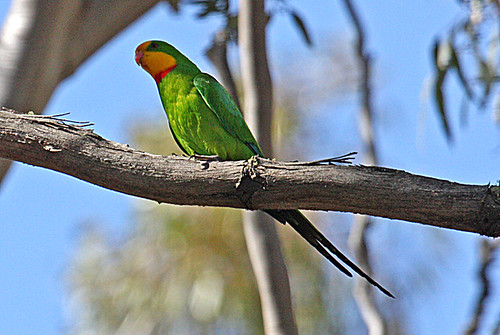 Superb Parrot (Polytelis swainsonii). Image by Tony MorrisMOTORISTS travelling through the Cowra, Young and Boorowa districts are asked to keep an eye out and slow down for the threatened superb parrot along regional roads.
Superb Parrot (Polytelis swainsonii). Image by Tony MorrisMOTORISTS travelling through the Cowra, Young and Boorowa districts are asked to keep an eye out and slow down for the threatened superb parrot along regional roads.
During harvest time this spectacular bright green parrot is attracted to spilled grain along roads and the Office of Environment and Heritage (OEH) receives reports of birds killed by vehicles each year.
When a superb parrot or any other bird lands to feed on spilled grain, they quickly become weighed down with the food and have difficulty flying away when vehicles are coming.
OEH threatened species co-ordinator, Damon Oliver, recently spoke to the Boorowa community about superb parrots and steps that can make a big different for this species.
Dr Oliver says efforts by grain-growers and carriers to cover their loads have helped to reduce road kills in recent years.
“About a decade ago many weighbridges and grain silos erected signs to remind operators about the unintended consequences for birds when grain is spilled,” says Dr Oliver.
“The responsibility is a shared one and we encourage motorists to slow down and sound the horn when parrots are in sight, because this brief inconvenience for drivers will help protect threatened birds.”
Dr Oliver says many landholders and community members in the region are aware of and very fond of their superb parrots, and are keen to see the species conserved.
“Another key to helping superb parrots is to protect large old trees which are essential breeding habitat for the species during spring and summer.
“Old and established trees are becoming very scarce across the landscape and I commend land managers who preserve them in paddocks, along roads, in towns and in patches of bush.
“We also need to think to the future by planting trees now as it takes around 150 years for trees to starting developing hollows for superb parrots and other animals,” says Dr Oliver.